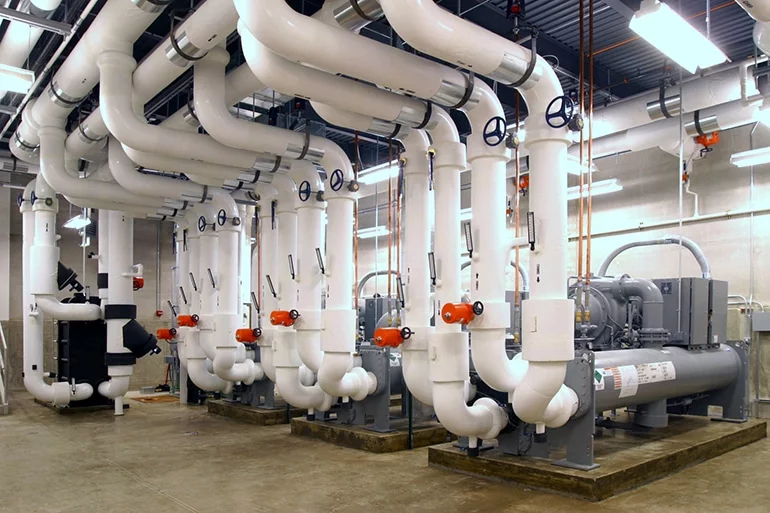Introduction
The installation of air conditioning water systems is a critical aspect of building climate control. It involves the integration of pipes and equipment designed to manage the flow of water, which is essential for cooling and heating processes.
Proper installation is crucial for ensuring efficiency and longevity in performance. Adhering to international standards and guidelines during this process can significantly enhance reliability and safety.
"Quality installation ensures optimal performance and energy efficiency for years to come"

Figure 1: Air conditioning water system pipeline
System Components
1 Pipes
Responsible for transporting water between the various components. High-quality materials ensure durability and resistance to corrosion.
2 Pumps
Facilitate the movement of water through the system. Proper sizing and placement are essential for efficient operation.
3 Valves
Control the flow and pressure, ensuring the system operates efficiently. Regular maintenance prevents leaks and malfunctions.
4 Heat Exchangers
Crucial for transferring heat between the refrigerant and water, enabling heating or cooling as needed.
Design Considerations
Piping Layout
The layout of the piping should minimize bends and turns to reduce pressure drops. Proper sizing of pipes is essential, as undersized pipes can lead to increased resistance and energy consumption.
Equipment Positioning
Equipment should be installed in locations that allow for easy access for maintenance and repair. Placement should optimize water flow and minimize leak risks.
Material Selection
The use of high-quality materials, such as those offered by Deign, is recommended to ensure durability and resistance to corrosion.
Compliance Standards
Compliance with international standards like ASHRAE 90.1 ensures designs meet energy efficiency requirements, reducing operational costs.
Installation Procedures
Choose the right location for the air conditioning unit
Gather all necessary tools and materials
Clear the installation site of any debris
Install the mounting brackets
Place the air conditioning unit onto brackets
Connect the water supply line
Install the drainage line
Seal all connections with appropriate sealants
Connect the electrical supply
Test the electrical connections
Turn on the water supply and check for leaks
Power on the air conditioning unit
Adjust the thermostat settings
Check the drainage line
Conduct final inspection
Pressure Testing
After the pipes and equipment are in place, pressure testing is conducted. This process verifies that there are no leaks in the system and that it can withstand the required operating pressures. It is essential to use calibrated testing equipment and follow the relevant international standards, such as ISO 9001, to ensure accuracy and safety.
Water Quality Management
Maintaining water quality is crucial in air conditioning water systems to prevent issues such as corrosion and biofilm formation. Regular monitoring of water chemistry is recommended to ensure that pH levels, hardness, and other parameters are within acceptable ranges.
Key Recommendations:
- Install filtration systems to remove impurities
- Use chemicals for water treatment cautiously
- Follow manufacturer's instructions for treatments
- Consider eco-friendly treatment options
- Regularly test water quality parameters
Compliance with Standards
Adhering to international standards is paramount in the installation of air conditioning water systems. Various standards provide guidelines on design, installation, and maintenance practices.
Maintenance & Monitoring
Routine maintenance is essential for the longevity of air conditioning water systems. Regular inspections can identify potential issues before they escalate into significant problems.
Best Practices:
- Check for leaks regularly
- Monitor flow rates consistently
- Ensure pumps and valves operate correctly
Implementing a monitoring system can enhance maintenance efforts. Advanced technology allows for real-time tracking of system performance, which can help in identifying inefficiencies and areas for improvement.
Conclusion
The installation of air conditioning water systems is a multifaceted process that requires careful consideration of design, materials, and compliance with international standards.
By following best practices and utilizing high-quality components, such as those from Deign, systems can achieve optimal efficiency and reliability. Regular maintenance and monitoring further enhance system longevity and performance.
Adhering to established guidelines not only ensures safety and compliance but also contributes to environmental sustainability and cost-effectiveness.
© 2023 Air Conditioning Water Systems Installation Guide. All rights reserved.
Following international standards ensures safety, efficiency, and sustainability in climate control systems.
 +86 18186671616
+86 18186671616 Jason@cleanroomequips.com
Jason@cleanroomequips.com
 MENU
MENU



